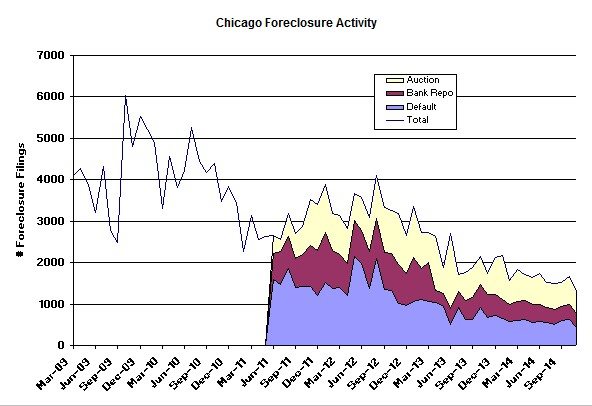RealtyTrac just released their November Foreclosure Market Report and the data shows a record low in Chicago foreclosure activity – well, at least it’s a record during the time I’ve been monitoring the data, which is 5 1/2 years. But since I started monitoring the data in 2009 and we know the problem was pretty bad well before 2009 we know this has to be a record low for at least 7 years or maybe more.
You can see the long term trend in the graph below. Total foreclosure activity in Chicago is down 25% from this time last year and down almost 80% from the peak that I knew about in 2009. The volatility of this data is also down considerably in the last few months. It’s as if we have reached a steady state.
At the national level November was the 50th consecutive month with a year over year decrease in foreclosure activity.
When you compare Chicago to other major metro areas (see RealtyTrac’s graph below) you see that we are experiencing more improvement than all but 4 cities, despite the fact that Chicago still has the 5th highest foreclosure rate in the nation.
Chicago Shadow Inventory
Chicago’s backlog of properties in the foreclosure pipeline continues to decline at a steady but slowing rate. So it’s certainly bottoming out.
RealtyTrac also presented another cool graph that shows the foreclosure rate by loan vintage and it does show an interesting trend. You can clearly see how loans made during the peak of the housing bubble had huge foreclosure rates and how those foreclosure rates have come down on loans made since then. However, it bottomed in 2012 and has been rising ever since. So is this a problem or were the lending standards in 2012 just too strict? After all, the foreclosure rates on loans made in 2000 were much higher than in 2012.
Daren Blomquist, vice president at RealtyTrac, addressed this very issue in the market report:
The housing market is struggling to find the new normal when it comes to a tolerable level of foreclosure activity in this post-Great Recession economy. Finding that new normal requires striking a balance between too much loan risk, which would result in another housing meltdown, and too little risk, which could result in a stunted recovery.
Foreclosure rates on 2014-originated loans are actually higher than 2013-originated loans nationwide and in many markets, indicating that lenders are open to a slightly higher level of risk than we’ve seen over the past five years of extremely tight lending standards. But it’s unlikely that lenders will dial up that risk level too quickly going forward given that many are still dealing with working through a lengthy and messy foreclosure process on risky loans from the last loose lending spree.
#realestate #chicagorealestate #foreclosures
If you want to keep up to date on the Chicago real estate market, get an insider’s view of the seamy underbelly of the real estate industry, or you just think I’m the next Kurt Vonnegut you can Subscribe to Getting Real by Email. Please be sure to verify your email address when you receive the verification notice.



